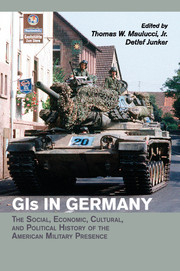15 results
Taking on Technocracy: Nuclear Power in Germany, 1945 to the Present By Dolores L. Augustine. New York: Berghahn Books, 2018. Pp. xiii + 286. Cloth $135.00. ISBN 978-1785336454.
-
- Journal:
- Central European History / Volume 55 / Issue 1 / March 2022
- Published online by Cambridge University Press:
- 01 April 2022, pp. 181-183
- Print publication:
- March 2022
-
- Article
- Export citation
Germany's Foreign Policy of Reconciliation: From Enmity to Amity. By Lily Gardner Feldman. Lanham, MD: Rowman & Littlefield, 2012. Pp. xvii + 393. Cloth $85.00. ISBN 978-0742526129.
-
- Journal:
- Central European History / Volume 47 / Issue 4 / December 2014
- Published online by Cambridge University Press:
- 04 March 2015, pp. 880-882
- Print publication:
- December 2014
-
- Article
- Export citation
GIs in Germany - Half title page
-
- Book:
- GIs in Germany
- Published online:
- 05 October 2013
- Print publication:
- 02 September 2013, pp i-ii
-
- Chapter
- Export citation
Series page
-
- Book:
- GIs in Germany
- Published online:
- 05 October 2013
- Print publication:
- 02 September 2013, pp iii-iv
-
- Chapter
- Export citation
Part Two - Military Communities
-
- Book:
- GIs in Germany
- Published online:
- 05 October 2013
- Print publication:
- 02 September 2013, pp 119-186
-
- Chapter
- Export citation
Acknowledgments
-
- Book:
- GIs in Germany
- Published online:
- 05 October 2013
- Print publication:
- 02 September 2013, pp xi-xii
-
- Chapter
- Export citation

GIs in Germany
- The Social, Economic, Cultural, and Political History of the American Military Presence
-
- Published online:
- 05 October 2013
- Print publication:
- 02 September 2013
Select Bibliography
-
- Book:
- GIs in Germany
- Published online:
- 05 October 2013
- Print publication:
- 02 September 2013, pp 353-358
-
- Chapter
- Export citation
Part Four - The German Armed Forces and the American Model
-
- Book:
- GIs in Germany
- Published online:
- 05 October 2013
- Print publication:
- 02 September 2013, pp 235-270
-
- Chapter
- Export citation
Copyright page
-
- Book:
- GIs in Germany
- Published online:
- 05 October 2013
- Print publication:
- 02 September 2013, pp vi-vi
-
- Chapter
- Export citation
Contents
-
- Book:
- GIs in Germany
- Published online:
- 05 October 2013
- Print publication:
- 02 September 2013, pp vii-viii
-
- Chapter
- Export citation
Part Three - Tensions between Neighbors
-
- Book:
- GIs in Germany
- Published online:
- 05 October 2013
- Print publication:
- 02 September 2013, pp 187-234
-
- Chapter
- Export citation
Index
-
- Book:
- GIs in Germany
- Published online:
- 05 October 2013
- Print publication:
- 02 September 2013, pp 359-365
-
- Chapter
- Export citation
Part Five - The 1970s and 1980s
-
- Book:
- GIs in Germany
- Published online:
- 05 October 2013
- Print publication:
- 02 September 2013, pp 271-346
-
- Chapter
- Export citation
Part One - Strategy and Politics
-
- Book:
- GIs in Germany
- Published online:
- 05 October 2013
- Print publication:
- 02 September 2013, pp 35-118
-
- Chapter
- Export citation



